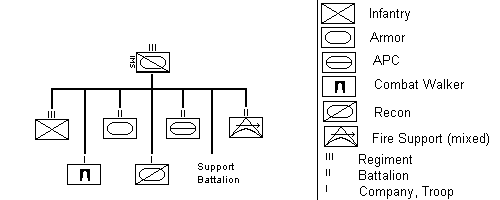

In 2301, IMS announced a major revision in the Table of Organization and Equipment (TO&E) for all of its ground military forces. This change was necessary due to changes in military doctrine and the renewed Kafer war offensive up the French Arm.
Hover Combat Regiments (HCRs) were previously organized along strict lines that yielded three combat squadrons, a fire support squadron, and a service squadron. Each combat squadron consisted of armor, mechanized infantry, and reconnaissance assets that were organized and functioned as a combined force. This organization broke up units from their parent units for the duration of their attachment to the HCR, which caused serious logistical problems and a loss in the flexibility needed by such a rapid attack force.
The re-organized HCR is now more of an administrative grouping of units that can be deployed into a combat situation, as was the original intent. Battle groups can be created from the various units that comprise the HCR as the situation warrants. This allows for much more tactical flexibility and minimizes logistics.
Each HCR consists of a number of sub units. The combat elements are of prime interest and are listed below. In addition to the combat elements are various support and logistical units that are attached to the HCR for the duration of its deployment.
Hover Combat Regiments are classified by the standard three digit numerical designation with an HCR suffix.
xxx HCR
Where xxx is a numerical designation for the composite regiment, and indicates the chronological order of formation, commencing from 100. All HCRs, HSRs, and ACRs are numbered sequentially as a group.

The combat elements of an HCR include an armor battalion, a mechanized battalion, an infantry battalion, a fire support battalion, a reconnaissance company, a combat support battalion, and a combat walker company.
The armor battalion contains either M-9 or LkPz-VIII hover main battle tanks. The mechanized battalion contains M24A3 hover APCs and is used as transportation for the infantry battalion. The fire support battalion consists of three platoons-air defense, anti-vehicle, and MRL. Reconnaissance capabilities for the HCR are provided by the reconnaissance company.
Immediate support is provided by the combat support battalion, which consists of five troops. The support troop (I) contains three BgLkPz-VIII for hover vehicle recovery. The medical troop (II) contains three M247 Casualty Evac hovercraft. The headquarters troop (III) consists of two M24A3 Tactical Operations Center hovercraft and one M241 Communications hovercraft. The supply section has two troops (IV, V), with each troop containing three M760 utility hovercraft.
The latest addition to the HCR is the combat walker company. Intended to provide highly mobile and rapid response, the company is carried by specially modified M760 hovercraft until the walkers are deployed.
Due to the recent Kafer offensive up the French Arm, HCRs have increased training fighting as a single battle group as the likelihood of deployments increase. As well, Hover Combat Brigades (HCB), comprised of two HCRs and one HSR, have also begun training exercises and maneuvers. Until recently, HCBs have only existed on paper, due to the logistical problems inherent to such large sized forces. However, with the potential for Kafer advancement up the French Arm increasing, it is likely that such units could be deployed in the defense of a world.
As of 2301, IMS has ten Hover Combat Regiments as full operational strength. Four are equipped with the LkPz-VIII hover tank, and the other six are equipped with the M-9 hover tank. Two more HCRs were expected to be formed in 2301, but with the shortage of men and the restructuring of all ground units, those forces have been re-allocated to existing units.
These web pages developed and maintained by Terry A. Kuchta